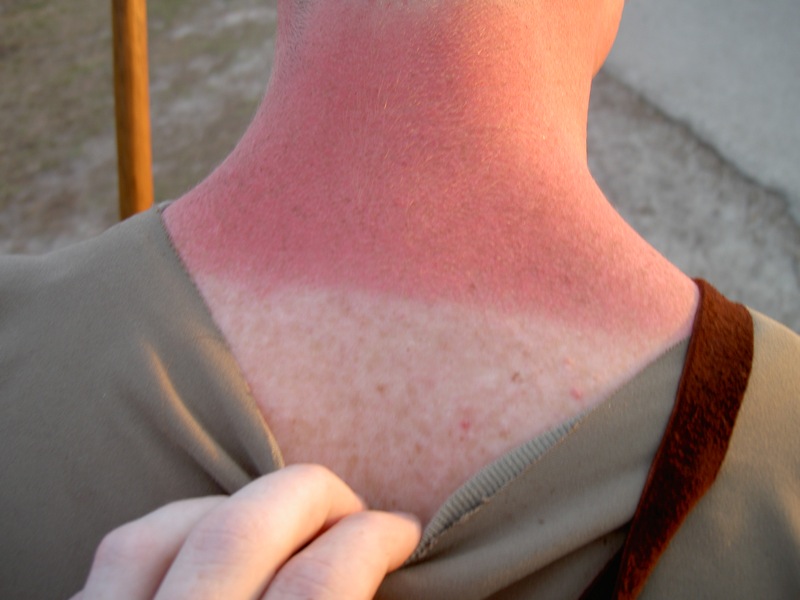Sunburn: Symptoms, Causes & Treatment
What are the symptoms of sunburn?
Sunburn is a skin reaction caused by overexposure to ultraviolet (UV) radiation from the sun or artificial sources like tanning beds. Symptoms of sunburn can vary depending on the severity of the burn but typically include:
- Redness: The skin becomes red and may feel warm to the touch. The severity of the redness can vary depending on the degree of sunburn.
- Pain and Tenderness: Sunburned skin is often painful, especially when touched or exposed to heat.
- Swelling: In more severe cases of sunburn, the affected area may become swollen.
- Blistering: Severe sunburn can cause the skin to blister. It’s important not to pop blisters, as this can increase the risk of infection.
- Peeling: After a few days, sunburned skin may begin to peel as the damaged skin cells are shed and replaced with new cells.
- Itching: Sunburned skin may be itchy as it heals.
- Fever and Chills: In severe cases of sunburn, a person may experience fever and chills, along with other symptoms of sun poisoning.
It’s important to protect your skin from sunburn by using sunscreen, wearing protective clothing, and seeking shade during peak sun hours. If you do get sunburned, it’s important to take steps to treat the burn and relieve symptoms, such as applying cool compresses, using moisturizing lotions, and taking over-the-counter pain relievers. If your sunburn is severe or if you experience symptoms like fever, chills, or severe blistering, seek medical attention.
What are the causes of sunburn?
Sunburn is primarily caused by overexposure to ultraviolet (UV) radiation from the sun. UV radiation can damage the DNA in skin cells, leading to inflammation and the characteristic symptoms of sunburn. There are several factors that can increase the risk of sunburn, including:
- Exposure to UV Radiation: Spending time in the sun without adequate protection exposes the skin to UV radiation, increasing the risk of sunburn. UV radiation is strongest between 10 a.m. and 4 p.m., so it’s important to seek shade and limit sun exposure during these hours.
- Skin Type: People with fair skin are more susceptible to sunburn because they have less melanin, the pigment that provides some protection against UV radiation. However, people with all skin types can get sunburned.
- Altitude: UV radiation is more intense at higher altitudes, so people at higher elevations are at increased risk of sunburn.
- Reflective Surfaces: Surfaces like sand, water, and snow can reflect UV radiation, increasing exposure and the risk of sunburn.
- Medications: Some medications can increase the skin’s sensitivity to UV radiation, making sunburn more likely. These medications include certain antibiotics, antifungals, and medications used to treat acne and other skin conditions.
- Sunlamps and Tanning Beds: Exposure to artificial sources of UV radiation, such as sunlamps and tanning beds, can also cause sunburn and increase the risk of skin cancer.
It’s important to protect your skin from sunburn by wearing sunscreen with a high SPF, seeking shade, and wearing protective clothing, such as hats and sunglasses. Sunburn can increase the risk of skin cancer and premature aging of the skin, so it’s important to take steps to prevent sunburn and protect your skin from UV radiation.
What is the treatment for sunburn?
The treatment for sunburn aims to relieve symptoms and promote healing. Here are some steps you can take to treat sunburn:
- Cool the Skin: Take a cool bath or shower, or apply cold compresses to the sunburned area to help cool the skin and reduce pain and inflammation.
- Moisturize: Apply a gentle moisturizing lotion or aloe vera gel to the sunburned skin to help soothe and hydrate the skin.
- Avoid Further Sun Exposure: Protect sunburned skin from further sun exposure until it has healed completely.
- Hydrate: Drink plenty of water to help hydrate your skin and promote healing from within. Avoiding dehydration is important.
- Pain Relief: Over-the-counter pain relievers such as ibuprofen or acetaminophen can help reduce pain and inflammation associated with sunburn.
- Avoid Popping Blisters: If your sunburn causes blisters, do not pop them, as this can increase the risk of infection. Let the blisters heal on their own.
- Protective Clothing: Wear loose, lightweight clothing that covers sunburned skin to protect it from further irritation.
- Stay Cool: Stay in a cool, shaded area to help reduce discomfort from sunburn.
Severe sunburn that covers a large area of the body or is accompanied by symptoms such as fever, chills, or severe pain may require medical attention. In such cases, a healthcare professional may recommend prescription-strength pain relievers, corticosteroid creams, or other treatments to help manage symptoms and promote healing. It’s important to protect your skin from further sun exposure and to take steps to prevent sunburn in the future by wearing sunscreen, seeking shade, and wearing protective clothing.




